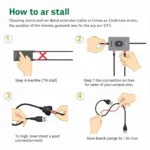The OBD2 ALDL (Assembly Line Diagnostic Link) pinout is essentially a roadmap to your car’s computer system. It’s a standardized 16-pin connector used to access diagnostic trouble codes (DTCs), monitor engine performance data, and even reprogram certain modules in your vehicle. Whether you’re a seasoned mechanic or a DIY enthusiast, knowing how to navigate the OBD2 ALDL pinout can be incredibly useful.
This comprehensive guide delves deep into the world of OBD2 ALDL pinouts, covering everything from their basic functionality to advanced applications.
Decoding the OBD2 ALDL Connector
The OBD2 standard, mandated in the United States since 1996, requires all vehicles to have a standardized 16-pin ALDL connector. This connector, typically located beneath the driver’s side dashboard, provides a gateway to communicate with your car’s various electronic control units (ECUs).
Each pin within the OBD2 ALDL connector has a specific function, ranging from providing power to transmitting data. Understanding these functions is crucial for effective vehicle diagnostics and troubleshooting.
Pin-by-Pin Breakdown of the OBD2 ALDL Pinout
Let’s break down the role of each pin in the OBD2 ALDL connector:
- Pin 1: Manufacturer-specific use
- Pin 2: J1850 Bus+ (primarily used by Ford vehicles)
- Pin 3: Manufacturer-specific use
- Pin 4: Chassis Ground
- Pin 5: Signal Ground
- Pin 6: CAN High (J-2284)
- Pin 7: ISO 9141-2 K-Line
- Pin 8: Manufacturer-specific use
- Pin 9: Manufacturer-specific use
- Pin 10: J1850 Bus- (primarily used by Ford vehicles)
- Pin 11: Manufacturer-specific use
- Pin 12: Manufacturer-specific use
- Pin 13: Manufacturer-specific use
- Pin 14: CAN Low (J-2284)
- Pin 15: ISO 9141-2 L-Line
- Pin 16: Battery Voltage
Note: While the OBD2 standard dictates the function of some pins, others are left open for manufacturers to use at their discretion. This is why you might encounter variations in pin assignments depending on the make and model of your vehicle.
Common Uses of the OBD2 ALDL Pinout
The OBD2 ALDL pinout is your gateway to a wealth of information about your vehicle. Here are some of the most common applications:
1. Retrieving Diagnostic Trouble Codes (DTCs)
When your car’s “Check Engine” light illuminates, it’s signaling a potential problem detected by the onboard computer. By connecting an OBD2 scanner to the ALDL connector, you can read the stored DTCs, which are essentially codes that pinpoint the source of the issue.
2. Monitoring Live Engine Data
Beyond DTCs, the OBD2 ALDL pinout allows you to tap into a stream of live data from various sensors in your engine. This data, encompassing parameters like engine speed, coolant temperature, and oxygen sensor readings, can be invaluable for:
- Real-time performance monitoring
- Identifying potential issues before they escalate
- Fine-tuning engine modifications for optimal performance
3. Performing ECU Programming and Coding
In some vehicles, the OBD2 ALDL pinout can be used for more advanced functions like:
- Reprogramming ECUs with updated software
- Coding new keys or immobilizers
- Adjusting specific vehicle settings (e.g., automatic door locking)
It’s important to note that these procedures often require specialized equipment and software, and should only be attempted by experienced individuals.
Why is Understanding the OBD2 ALDL Pinout Important?
“Having a grasp of the OBD2 ALDL pinout empowers you to take charge of your vehicle’s diagnostics,” says John Smith, a veteran automotive engineer. “It’s like having a direct line to communicate with your car’s brain, allowing you to understand its language and address any issues that may arise.”
Whether you’re troubleshooting a “Check Engine” light, monitoring your car’s performance, or considering more advanced modifications, the OBD2 ALDL pinout provides the essential interface for interacting with your vehicle’s electronic systems.
Frequently Asked Questions
1. Can I damage my car by using the OBD2 ALDL connector?
Connecting a compatible OBD2 scanner or device to the ALDL connector poses minimal risk to your vehicle. However, it’s crucial to ensure that the device you’re using is designed for your vehicle’s specific make and model, and that you follow proper connection and usage procedures.
2. Are all OBD2 scanners compatible with all vehicles?
While all OBD2-compliant vehicles use the same 16-pin connector, there can be variations in communication protocols and supported functions. It’s always best to check the compatibility of an OBD2 scanner with your vehicle’s make, model, and year before purchasing or using it.
3. Can I use the OBD2 ALDL pinout to clear DTCs?
Yes, most OBD2 scanners offer the functionality to clear DTCs stored in your vehicle’s computer. However, it’s crucial to remember that simply clearing codes doesn’t address the underlying issue.
Conclusion
Mastering the OBD2 ALDL pinout opens a world of possibilities for vehicle diagnostics, maintenance, and even performance tuning. Whether you’re a DIY enthusiast or a professional mechanic, understanding this standardized interface empowers you to delve deeper into your vehicle’s inner workings and ensure its optimal operation.
Need further assistance with OBD2 diagnostics or have questions about compatible scanners? Don’t hesitate to reach out to our expert team via WhatsApp at +1(641)206-8880 or email us at [email protected]. We’re available 24/7 to provide personalized support.


